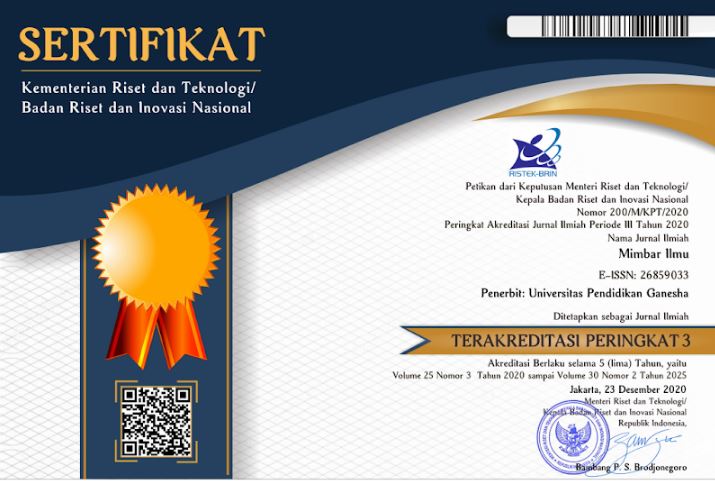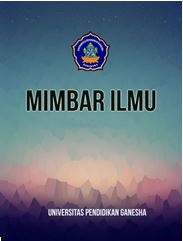E-Learning Efektif Sebagai Media Pembelajaran Saat Pandemi Covid-19
DOI:
https://doi.org/10.23887/mi.v26i3.41842Keywords:
E-learning, Media Pembelajaran, TCRAbstract
Masih banyak mahasiswa yang belum familiar akan fitur Big Blue Button ini dikarenakan belum optimalnya sosialisasi terhadap fitur yang ada di E-learning. Selain itu, banyak dosen yang lebih memilih menggunakan zoom cloud meetings karena pemakaiannya lebih mudah dan stabil. Penelitian ini bertujuan untuk menganalisis efektivitas penggunaan E-learning sebagai media pembelajaran saat pandemi covid-19. Penelitian ini adalah penelitian deskriptif dengan metode kuantitatif. Teknik pengumpulan data menggunakan kuesioner yang diberikan melalui google form. Subjek penelitian ini adalah mahasiswa pascasarjana pendidikan teknologi dan kejuruan sejumlah 21 mahasiswa. Teknik sampling yang digunakan dalam penelitian ini adalah probability sampling. Pengambilan sampel menggunakan Simple Random Sampling. Kuesioner dibuat memakai skala likert yang ada lima alternatif jawaban. Teknik yang digunakan untuk menganalisis data yaitu analisis statistic kualitatif dan kuantitatif. Hasil penelitian yaitu indikator tujuan pembelajaran dilihat bahwa tingkat capaian responden (TCR) mencapai 77,20% dengan kategori cukup. Indikator sarana prasarana pembelajaran dilihat bahwa TCR mencapai 82,07% dengan kategori baik. Indikator kemampuan menggunakan teknologi dilihat bahwa TCR mencapai 81,18% dengan kategori baik. Indikator efisiensi waktu dilihat bahwa TCR mencapai 81,93% dengan kategori baik. Indikator hasil pembelajaran dilihat bahwa TCR mencapai 86,70%. Dengan demikian dapat disimpulkan bahwa penggunaan E-learning sebagai media pembelajaran saat pandemi covid-19 dikategorikan efektif, bisa dilihat dari hasil penelitian pada 5 indikator ada 4 indikator yang kategori baik dan ada 1 yang kategori cukup.
References
Abuhassna, H., Al-rahmi, W. M., Yahya, N., Aman, M., & Megat, Z. (2020). Development of a new model on utilizing online learning platforms to improve students ’ academic achievements and satisfaction. International Journal of Educational Technology in Higher Education, 17(73), 2–23. https://doi.org/10.1186/s41239-020-00216-z.
Abuhassna, H., Al-Rahmi, W. M., Yahya, N., Zakaria, M. A. Z. M., Kosnin, A. B. M., & Darwish, M. (2020). Development of a new model on utilizing online learning platforms to improve students’ academic achievements and satisfaction. International Journal of Educational Technology in Higher Education, 17(1), 1–23. https://doi.org/10.1186/S41239-020-00216-Z.
Aini, Q., Putra, P. O. H., Budiarto, M., & Rahardja, U. (2020). Exploring E-learning Challenges During the Global COVID-19 Pandemic: A Review. Jurnal Sistem Informasi (Journal of Information System), 16(2), 57–65. https://doi.org/10.21609/jsi.v16i2.1011.
Ali, W. (2020). Online and Remote Learning in Higher Education Institutes: A Necessity in light of COVID-19 Pandemic. Higher Education Studies, 10(3), 16–25. https://doi.org/10.5539/hes.v10n3p16.
Almaiah, M. A., Al-Khasawneh, A., & Althunibat, A. (2020). Exploring the critical challenges and factors influencing the E-learning system usage during COVID-19 pandemic. Education and Information Technologies, 25(6), 5261–5280. https://doi.org/10.1007/s10639-020-10219-y.
Alshammari, M. T. (2020). Evaluation of gamification in e-learning systems for elementary school students. TEM Journal, 9(2). https://doi.org/10.18421/TEM92-51.
Andel, S. A., de Vreede, T., Spector, P. E., Padmanabhan, B., Singh, V. K., & Vreede, G. J. de. (2020). Do social features help in video-centric online learning platforms? A social presence perspective. Computers in Human Behavior, 113(April), 106505. https://doi.org/10.1016/j.chb.2020.106505.
Anitha Kumari, T., Hemalatha, C. H., Subhani Ali, M., & Naresh, R. (2020). Survey on impact and learning’s of the online courses on the present era. Procedia Computer Science, 172, 82–91. https://doi.org/10.1016/j.procs.2020.05.167.
Arifuddin, Suwatra, & Mahadewi. (2020). Pengembangan Konten E-learning Berorientasi Pendidikan Karakter Pada Mata Pelajaran Seni Budaya. Jurnal Edutech Undiksha, 8(2). https://doi.org/10.23887/jeu.v8i2.28942.
Aris, B., Ardian, A., & Ferry, M. (2019). Pengembangan Media Pembelajaran Berbasis E-Learning Pada SMK di Pontianak. Jurnal Nasional Komputasi Dan Teknologi Informasi (JNKTI), 2(2), 133. https://doi.org/10.32672/jnkti.v2i2.1556.
Astalini, A., Darmaji, D., Kurniawan, W., Anwar, K., & Kurniawan, D. A. (2019). Effectivenes of Using E-Module and E-Assessment. International Journal of Interactive Mobile Technologies (IJIM), 13(09), 21–39. https://doi.org/10.3991/ijim.v13i09.11016.
Barakhsanova, E. A., Prokopyev, M. S., Olesova, S. G., Olesov, N. P., Lukina, T. N., Sorochinskiy, M. A., & Tatarinov, F. F. (2020). Transdisciplinary Approach To the Learning Process Organization in the E-Learning Information Environment of a College. International Transaction Journal of Engineering Management & Applied Sciences & Technologies, 11(3), 1–12. https://doi.org/10.14456/ITJEMAST.2020.53.
Bipinchandra, J. S. a/p, Shah, P. M., Puteh, S. N., Din, R., Rahamat, R., & Aziz, J. A. (2014). User Needs Analysis in Learning Argumentative Writing Via Mobile Platform. Procedia - Social and Behavioral Sciences, 118. https://doi.org/10.1016/j.sbspro.2014.02.027.
Browning, M. H. E. M., Larson, L. R., Sharaievska, I., Rigolon, A., McAnirlin, O., Mullenbach, L., Cloutier, S., Vu, T. M., Thomsen, J., Reigner, N., Metcalf, E. C., D’Antonio, A., Helbich, M., Bratman, G. N., & Alvarez, H. O. (2021). Psychological impacts from COVID-19 among university students: Risk factors across seven states in the United States. PloS One, 16(1), e0245327. https://doi.org/10.1371/journal.pone.0245327.
Calvo, C., López-hortelano, M. G., Carlos, J., Vicente, D. C., Luis, J., Martínez, V., ..., & Asociación, D. (2020). Recommendations on the Clinical Management of the COVID-19 Infection by the (new Coronavirus) SARS-CoV2. Clinical Management of Infection, 92(4). https://doi.org/10.1016/j.anpede.2020.02.002.
Gerhardt-Szép, S., Dreher, S., Rüttermann, S., & Weberschock, T. (2017). Konzeption und Implementierung eines neuartigen E-Learning-Moduls mit EbM-Lerninhalten im Fach Zahnerhaltungskunde. Zeitschrift Für Evidenz, Fortbildung Und Qualität Im Gesundheitswesen, 127–128, 72–78. https://doi.org/10.1016/j.zefq.2017.09.001.
Guan, W., Ni, Z., Hu, Y., Liang, W., Ou, C., He, J., Liu, L., Shan, H., Lei, C., Hui, D. S. C., Du, B., Li, L., Zeng, G., Yuen, K.-Y., Chen, R., Tang, C., Wang, T., Chen, P., Xiang, J., … Zhong, N. (2020). Clinical Characteristics of Coronavirus Disease 2019 in China. New England Journal of Medicine, 382(18), 1708–1720. https://doi.org/10.1056/NEJMoa2002032.
Hanik, E. U. (2020). Self directed learning berbasis literasi digital pada masa pandemi covid-19 di Madrasah Ibtidaiyah. ELEMENTARY: Islamic Teacher Journal, 8(1), 183. https://doi.org/10.21043/elementary.v8i1.7417.
Hincal, E., & Alsaadi, S. H. (2021). Stability analysis of fractional order model on corona transmission dynamics. Chaos, Solitons & Fractals, 143, 110628. https://doi.org/10.1016/j.chaos.2020.110628.
Iswara, I. B. A. I., & Yasa, I. P. P. K. (2021). Analisis Dan Perbandingan Quality Of Service Video Conference Jitsi Dan Bigbluebutton Pada Virtual Private Server. Jurnal Resistor, 4(2). https://doi.org/10.31598/jurnalresistor.v4i2.794.
Khamparia, A., & Pandey, B. (2017). Impact of interactive multimedia in E-learning technologies: Role of multimedia in E-learning. Enhancing Academic Research With Knowledge Management Principles, April, 199–227. https://doi.org/10.4018/978-1-5225-2489-2.ch007.
Khasawneh, R., Simonsen, K., Snowden, J., Higgins, J., Beck, G., Khasawneh, R., Simonsen, K., Snowden, J., Higgins, J., & Beck, G. (2016). The Effectiveness of E-Learning in Pediatric Medical Student Education. Medical Education Online, 21(1), 1–3. https://doi.org/10.3402/meo.v21.29516.
Kim, S.-H., & Sihyun Park. (2021). Influence of Learning Flow and Distance E-Learning Satisfaction on Learning Outcomes and the Moderated Mediation Effect of Social-Evaluative Anxiety in Nursing College Students during the COVID-19 Pandemic: A Cross-Sectional Study. Nurse Education in Practice, 6(103197). https://doi.org/10.1016/j.nepr.2021.103197.
Logan, R. M., Johnson, C. E., & Worsham, J. W. (2021). Development of an E-learning Module to Facilitate Student Learning and Outcomes. Teaching and Learning in Nursing, 16(2), 139–142. https://doi.org/10.1016/j.teln.2020.10.007.
Luckyardi, S., & Rahman, L. (2021). Application of E-Learning System in the World of Education. Jurnal Teknologi Informasi Dan Pendidikan, 14(1), 47–52. https://doi.org/10.24036/tip.v14i1.327.
Madleňák, R. et al. (2015). Designing a Social Network to Support E-learning Activities at the Department of Communications, University of Žilina. Procedia - Social and Behavioral Sciences, 176, 103–110. https://doi.org/10.1016/j.sbspro.2015.01.449.
Maulana, H. A. &, & Iswari, R. D. (2020). Analisis Tingkat Stres Mahasiswa Terhadap Pembelajaran Daring Pada Mata Kuliah Statistik Bisnis di Pendidikan Vokasi. Jurnal Ilmiah Kependidikan, 14(1), 17–30. https://doi.org/10.30595/jkp.v14i1.8479.
Mayer, R. E. (2017). Using multimedia for e-learning. Journal of Computer Assisted Learning, 33(5), 403–423. https://doi.org/10.1111/jcal.12197.
Nurliawaty, L., Mujasam, M., Yusuf, I., & Widyaningsih, S. W. (2017). Lembar Kerja Peserta Didik (LKPD) Berbasis Problem Solving Polya. JPI (Jurnal Pendidikan Indonesia), 6(1), 72–81. https://doi.org/10.23887/jpi-undiksha.v6i1.9183.
Nuryadi, N., Kurniawan, L., & Kholifa, I. (2020). Developing mobile learning based on ethnomathematics viewed from adaptive e-learning: Study of two dimensions geometry on Yogyakarta palace’s chariot. International Journal of Education and Learning, 2(1), 32–41. https://doi.org/10.31763/ijele.v2i1.85.
Ogbonna, C. G., Ibezim, N. E., & Obi, C. A. (2019). Synchronous versus asynchronous e-learning in teaching word processing: An experimental approach. South African Journal of Education, 39(2), 1–15. https://doi.org/10.15700/saje.v39n2a1383.
Permatasari, I., & Hardiyan, H. (2018). Pengaruh E-Learning Sebagai Media Pelatihan dan Pengembangan Terhadap Kinerja Karyawan BCA KCU Tangerang. Jurnal Sisfokom (Sistem Informasi Dan Komputer), 7(1), 1. https://doi.org/10.32736/sisfokom.v7i1.275.
Pratiwi, I., Suartama, I. K., & Tegeh, I. M. (2016). Pengembangan E-Learning dengan Model Prototype Berorientasi Model Pembelajaran Inquiry Siswa Kelas VII SMPN 2 Negara. Jurnal Edutech Undiksha, 4(2). https://doi.org/10.23887/jeu.v4i2.7615.
Putri, V. D. (2020). Layanan Bimbingan dan Konseling Daring Selama Masa Pandemi COVID-19. Jurnal Bimbingan Konseling Pendidikan Islam, 1(2), 7–16. https://doi.org/10.47453/coution.v1i2.95.
Rangga, P., Wirasti, M. K., & Kustandi, C. (2016). Bahan Belajar Mandiri Pengoperasian BigBlueButton Bagi Mentor/Pengampu Program Guru Pembelajar. Jurnal Pembelajaran Inovatif, 1(1). https://doi.org/10.21009/JPI.011.02.
Sayıner, A. A., & Ergönül, E. (2021). E-learning in clinical microbiology and infectious diseases. Clinical Microbiology and Infection, 28. https://doi.org/10.1016/j.cmi.2021.05.010.
Shah, K., Arfan, M., Mahariq, I., Ahmadian, A., Salahshour, S., & Ferrara, M. (2020). Fractal-Fractional Mathematical Model Addressing the Situation of Corona Virus in Pakistan. Results in Physics, 19, 103560. https://doi.org/10.1016/j.rinp.2020.103560.
Shetu, S. F., Rahman, M. M., Ahmed, A., Mahin, M. F., Akib, M. A. U., & Saifuzzaman, M. (2021). Impactful e-learning framework: A new hybrid form of education. Current Research in Behavioral Sciences, 2(April), 100038. https://doi.org/10.1016/j.crbeha.2021.100038.
Soni, Hafid, Hayami, Fatma, Wenando, Amien, Fuad, Unik, & Mukhtar. (2018). Optimalisasi Penggunaan Google Classroom, E-Learning & Blended Learning sebagai Media Pembelajaran Bagi Guru dan Siswa di SMK Negeri 1 Bangkinang. Jurnal Pengabdian Untukmu Negeri, 21. https://doi.org/10.37859/jpumri.v2i1.361.
Sorensen, E. (2013). Implementation and student perceptions of e-assessment in a Chemical Engineering module. European Journal of Engineering Education, 38(2), 172–185. https://doi.org/10.1080/03043797.2012.760533.
Sugiyono. (2018). Metode Penelitian Pendidikan Pendekatan Kuantitatif, Kualitatif dan R&D. Alfa Beta.
Suprapto, A. (2019). Analisis dimensi kebutuhan pra implementasi e-learning untuk meningkatkan mutu layanan pendidikan kampus di era revolusi industri 4.0. Attarbiyah, 28, 81. https://doi.org/10.18326/tarbiyah.v28i0.81-97.
Tamboto, H., Tambingon, H. N., Lengkong, J. S. ., & Rotty, V. N. J. (2021). The Involvement of Students’ Parents in Organizing the Learning from Home at Elementary Schools in Tomohon City. Asia Pacific Journal of Management and Education, 4(1), 35–51. https://doi.org/10.32535/apjme.v4i1.1044.
Tang, Y. M., Chen, P. C., Law, K. M. Y., Wu, C. H., Lau, Y., Guan, J., He, D., & Ho, G. T. S. (2021). Comparative analysis of Student’s live online learning readiness during the coronavirus (COVID-19) pandemic in the higher education sector. Computers & Education, 168, 104211. https://doi.org/10.1016/j.compedu.2021.104211.
Velan, G. M., Goergen, S. K., Grimm, J., & Shulruf, B. (2015). Impact of Interactive e-Learning Modules on Appropriateness of Imaging Referrals: A Multicenter, Randomized, Crossover Study. Journal of the American College of Radiology, 12(11). https://doi.org/10.1016/j.jacr.2015.06.026.
Virgiawan, M. D., Meryansumayeka, & Marlini, S. (2018). Pengembangan Kuis Interaktif Berbasis E-Learning Dengan Menggunakan Aplikasi Wondershare Quiz Creator Pada Mata Kuliah Belajar Dan Pembelajaran Matematika. Jurnal Pendidikan Matematika, 12(1), 29–42. https://doi.org/10.22342/jpm.12.1.5094.29-42.
Wahyuni, A. S., Warpala, I. W. S., & Agustini, K. (2020). Pengembangan Konten E-Learning Berbasis Self Regulated Learning untuk Meningkatkan Hasil Belajar Airline Reservation. Jurnal Teknologi. https://doi.org/10.23887/jtpi.v10i1.3394.
Weldon, A., Ma, W. W. K., Ho, I. M. K., & Ma, W. W. K. (2021). Online learning during a global pandemic : Perceived benefits and issues in higher education. Knowledge Management & E-Learning, 13(2), 161–181. https://doi.org/10.34105/j.kmel.2021.13.009.
Wen, J., Cheng, Y., Ling, R., Dai, Y., Huang, B., Huang, W., Zhang, S., & Jiang, Y. (2020). International Journal of Infectious Diseases Antibody-dependent enhancement of coronavirus. International Journal of Infectious Diseases, 100, 483–489. https://doi.org/10.1016/j.ijid.2020.09.015.
Yulia, H. (2020). Online Learning to Prevent the Spread of Pandemic Corona Virus in Indonesia. English Teaching Journal, 11, 48–56. https://doi.org/10.26877/eternal.v11i1.6068.
Zalat, M. M., Hamed, M. S., & Bolbol, S. A. (2021). The experiences , challenges , and acceptance of e-learning as a tool for teaching during the COVID-19 pandemic among university medical staff. PLoS ONE, 16(3), 1–12. https://doi.org/10.1371/journal.pone.0248758.
Downloads
Published
How to Cite
Issue
Section
License
This work is licensed under a Creative Commons Attribution-ShareAlike 4.0 International License.
Authors who publish with this journal agree to the following terms:
- Authors retain copyright and grant the journal right of first publication with the work simultaneously licensed under a Creative Commons Attribution License that allows others to share the work with an acknowledgment of the work's authorship and initial publication in this journal.
- Authors are able to enter into separate, additional contractual arrangements for the non-exclusive distribution of the journal's published version of the work (e.g., post it to an institutional repository or publish it in a book), with an acknowledgment of its initial publication in this journal.
- Authors are permitted and encouraged to post their work online (e.g., in institutional repositories or on their website) prior to and during the submission process, as it can lead to productive exchanges, as well as earlier and greater citation of published work.









